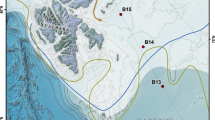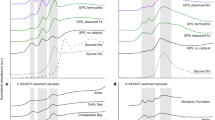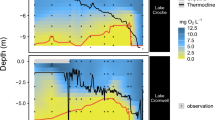Abstract
The biogeochemical cycles of iron and organic carbon are strongly interlinked. In oceanic waters, organic ligands have been shown to control the concentration of dissolved iron1. In soils, solid iron phases shelter and preserve organic carbon2, but the role of iron in the preservation of organic matter in sediments has not been clearly established. Here we use an iron reduction method previously applied to soils3 to determine the amount of organic carbon associated with reactive iron phases in sediments of various mineralogies collected from a wide range of depositional environments. Our findings suggest that 21.5 ± 8.6 per cent of the organic carbon in sediments is directly bound to reactive iron phases. We further estimate that a global mass of (19–45) × 1015 grams of organic carbon is preserved in surface marine sediments as a result of its association with iron4. We propose that these associations between organic carbon and iron, which are formed primarily through co-precipitation and/or direct chelation, promote the preservation of organic carbon in sediments. Because reactive iron phases are metastable over geological timescales, we suggest that they serve as an efficient ‘rusty sink’ for organic carbon, acting as a key factor in the long-term storage of organic carbon and thus contributing to the global cycles of carbon, oxygen and sulphur5.
This is a preview of subscription content, access via your institution
Access options
Subscribe to this journal
Receive 51 print issues and online access
$199.00 per year
only $3.90 per issue
Buy this article
- Purchase on Springer Link
- Instant access to full article PDF
Prices may be subject to local taxes which are calculated during checkout


Similar content being viewed by others
References
Johnson, K. S., Gordon, R. M. & Coale, K. H. What controls dissolved iron in the world ocean? Mar. Chem. 57, 137–161 (1997)
Kaiser, K. & Guggenberger, G. The role of DOM sorption to mineral surfaces in the preservation of organic matter in soils. Org. Geochem. 31, 711–725 (2000)
Wagai, R. & Mayer, L. M. Sorptive stabilization of organic matter in soils by hydrous iron oxides. Geochim. Cosmochim. Acta 71, 25–35 (2007)
Hedges, J. I. & Keil, R. G. Sedimentary organic matter preservation: an assessment and speculative synthesis. Mar. Chem. 49, 81–115 (1995)
Berner, R. A. The long-term carbon cycle, fossil fuels and atmospheric composition. Nature 426, 323–326 (2003)
Berner, R. A. Sedimentary pyrite formation. Am. J. Sci. 268, 1–23 (1970)
Boudot, J.-P., Bel Hadj, B. A., Steiman, R. & Seigle-Murandi, F. Biodegradation of synthetic organo-metallic complexes of iron and aluminum with selected metal to carbon ratios. Soil Biol. Biochem. 21, 961–966 (1989)
Jones, D. L. & Edwards, A. C. Influence of sorption on the biological utilization of two simple carbon substrates. Soil Biol. Biochem. 30, 1895–1902 (1998)
Poulton, S. W. & Raiswell, R. Chemical and physical characteristics of iron oxides in riverine and glacial meltwater sediments. Chem. Geol. 218, 203–221 (2005)
van der Zee, C., Roberts, D. R., Rancourt, D. G. & Slomp, C. P. Nano-goethite is the dominant reactive oxyhydroxide phase in lake and marine sediments. Geology 31, 993–996 (2003)
Canfield, D. E. The geochemistry of river particulates from the continental USA: Major elements. Geochim. Cosmochim. Acta 61, 3349–3365 (1997)
Burdige, D. J. Geochemistry of Marine Sediments 107 108 (Princeton Univ. Press, 2006)
Schwertmann, U. Inhibitory effect of soil organic matter on the crystallization of amorphous hydroxide. Nature 212, 645–646 (1966)
Haese, R. R. et al. Iron species determination to investigate early diagenetic reactivity in marine sediments. Geochim. Cosmochim. Acta 61, 63–72 (1997)
Mehra, O. P. & Jackson, M. L. Iron oxide removal from soils and clays by a dithionite-citrate system buffered with sodium bicarbonate. Clays Clay Miner. 7, 317–327 (1958)
Mayer, L. M. Extent of coverage of mineral surfaces by organic matter in marine sediments. Geochim. Cosmochim. Acta 63, 207–215 (1999)
Ransom, B., Bennet, R. H., Baerwald, R. & Shea, K. TEM study of in situ organic matter on continental margins: occurrence and the “monolayer” hypothesis. Mar. Geol. 138, 1–9 (1997)
Mackey, D. J. & Zirino, A. Comments on trace metal speciation in seawater or do “onions” grow in the sea? Anal. Chim. Acta 284, 635–647 (1994)
Guggenberger, G. & Kaiser, K. Dissolved organic matter in soil: challenging the paradigm of sorptive preservation. Geoderma 113, 293–310 (2003)
Baas Becking, L. G. M. & Moore, D. The relation between iron and organic matter in sediments. J. Sedim. Petrol. 29, 454–458 (1959)
Deflandre, B., Mucci, A., Gagné, J.-P., Guignard, C. & Sundby, B. Early diagenetic processes in coastal marine sediments disturbed by a catastrophic sedimentation event. Geochim. Cosmochim. Acta 66, 2547–2558 (2002)
Rue, E. L. & Bruland, K. W. Complexation of iron(III) by natural organic ligands in the Central North Pacific as determined by a new competitive ligand equilibration/adsorptive cathodic stripping voltammetric method. Mar. Chem. 50, 117–138 (1995)
Kraemer, S. M. Iron oxide dissolution and solubility in the presence of siderophores. Aquat. Sci. 66, 3–18 (2004)
Arnarson, T. S. & Keil, R. G. Changes in organic matter-mineral interactions for marine sediments with varying oxygen exposure time. Geochim. Cosmochim. Acta 71, 3545–3556 (2007)
Wang, Z.-C., Druffel, E. R. M., Griffin, S., Lee, C. & Kashgarian, M. Radiocarbon studies of organic compound classes in plankton and sediment of the Northeastern Pacific Ocean. Geochim. Cosmochim. Acta 62, 1365–1378 (1998)
Hedges, J. I., Keil, R. G. & Benner, R. What happens to terrestrial organic matter in the ocean? Org. Geochem. 27, 195–212 (1997)
Mayer, L. M. Surface area control on organic carbon accumulation in continental margin sediments. Geochim. Cosmochim. Acta 58, 1271–1284 (1994)
Mayer, L. M. Speculative organic matter preservation: an assessment and speculative synthesis – a comment. Mar. Chem. 49, 123–126 (1995)
Acknowledgements
This work is dedicated to the memory of J. I. Hedges; in addition to being an inspiration to Y.G., he provided several sediment samples used in this work. We thank H. T. Yan for surface area measurements and the captains and crews of RV Coriolis II for their help during sampling missions on the St Lawrence estuary. L. N. Barazzuol is also acknowledged for her work during the first phase of the project. This work was supported by grants (Y.G. and A.M.) and scholarships (K.L.) from NSERC, CFI and FQRNT. This is GEOTOP contribution no. 2012-0001.
Author information
Authors and Affiliations
Contributions
The original hypothesis was formulated by Y.G., and K.L., Y.G. and A.M. designed the project, interpreted the data and wrote the manuscript. K.L. gathered all the data. Groundwork for this study was carried out by A.O., who also contributed to the writing of the manuscript.
Corresponding author
Ethics declarations
Competing interests
The authors declare no competing financial interests.
Supplementary information
Supplementary Information
This file contains Supplementary Methods, Supplementary Tables 1-3, Supplementary Figures 1-2 and additional references. (PDF 243 kb)
PowerPoint slides
Rights and permissions
About this article
Cite this article
Lalonde, K., Mucci, A., Ouellet, A. et al. Preservation of organic matter in sediments promoted by iron. Nature 483, 198–200 (2012). https://doi.org/10.1038/nature10855
Received:
Accepted:
Published:
Issue Date:
DOI: https://doi.org/10.1038/nature10855
This article is cited by
-
Palaeozoic cooling modulated by ophiolite weathering through organic carbon preservation
Nature Geoscience (2024)
-
The chemical succession in anoxic lake waters as source of molecular diversity of organic matter
Scientific Reports (2024)
-
Preservation of Soil Iron-Bound Organic Carbon in a Karst Ditch Wetland: A Case Study in Caohai Lake, China
Journal of Soil Science and Plant Nutrition (2024)
-
Characteristics, origins, and significance of pyrites in deep-water shales
Science China Earth Sciences (2024)
-
Spartina alterniflora raised sediment sulfide in a tidal environment and buffered it with iron in the Jiuduansha Wetland
Journal of Soils and Sediments (2024)
Comments
By submitting a comment you agree to abide by our Terms and Community Guidelines. If you find something abusive or that does not comply with our terms or guidelines please flag it as inappropriate.



